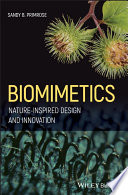

Most ebook files are in PDF format, so you can easily read them using various software such as Foxit Reader or directly on the Google Chrome browser.
Some ebook files are released by publishers in other formats such as .awz, .mobi, .epub, .fb2, etc. You may need to install specific software to read these formats on mobile/PC, such as Calibre.
Please read the tutorial at this link: https://ebookbell.com/faq
We offer FREE conversion to the popular formats you request; however, this may take some time. Therefore, right after payment, please email us, and we will try to provide the service as quickly as possible.
For some exceptional file formats or broken links (if any), please refrain from opening any disputes. Instead, email us first, and we will try to assist within a maximum of 6 hours.
EbookBell Team

4.3
88 reviewsProvides a professional, contemporary, and concise review of the current knowledge and advances in biomimetics
This book covers the field of biomimicry, an area of science where researchers look to mimic aspects of plants or animals in order to solve problems in aerospace, shipping, building, electronics, and optics, among others. It presents the latest developments in biomimicry and gives readers sufficient grounding to help them understand the current, and sometimes technically complex, research literature. Different themes are covered throughout and text boxes deal with the relevant physics for readers who may lack this knowledge.
Biomimetics: Nature-Inspired Design and Innovation examines issues in fluid dynamics such as avoiding sonic booms, reducing train noise, increasing wind turbine efficiency, and more. Next, it looks at optical applications, e.g. how nature generates color without dyes and pigment, and how animals stay cool in desert environments. A chapter on the built environment discusses cooling systems for buildings based on termite mounds; creating self-cleaning paint based on lotus leaves; unobtrusive solar panels based on ivy; and buildings that respond to the environment. Two more sections focus on biomimicry for the creation of smart materials and smart devices. The book finishes with a look at the field’s future over the next decade.